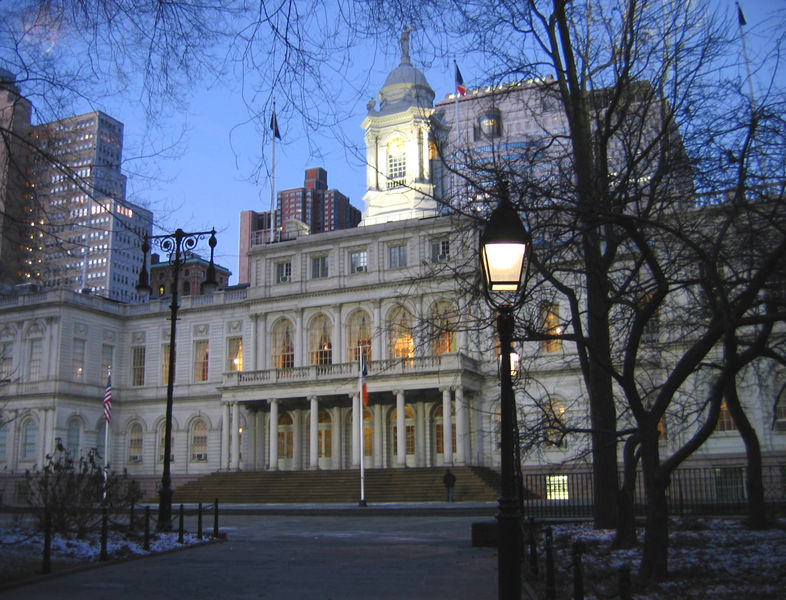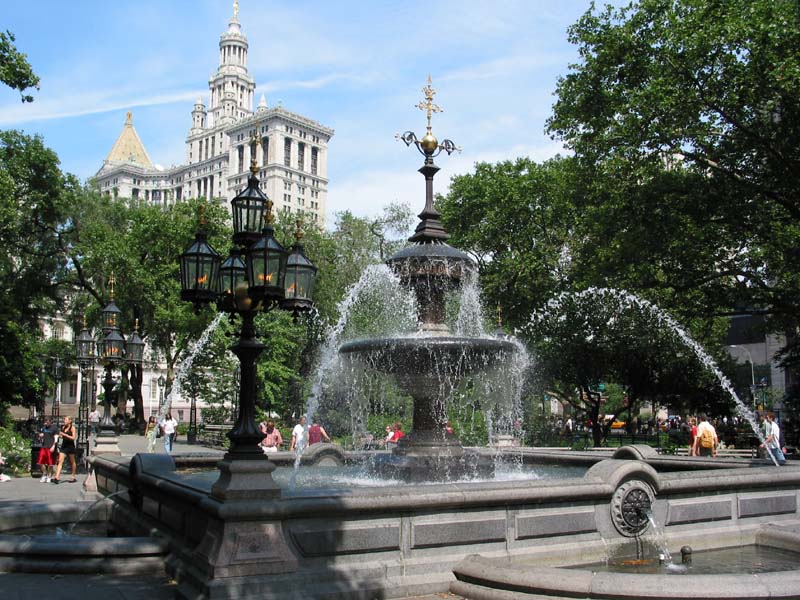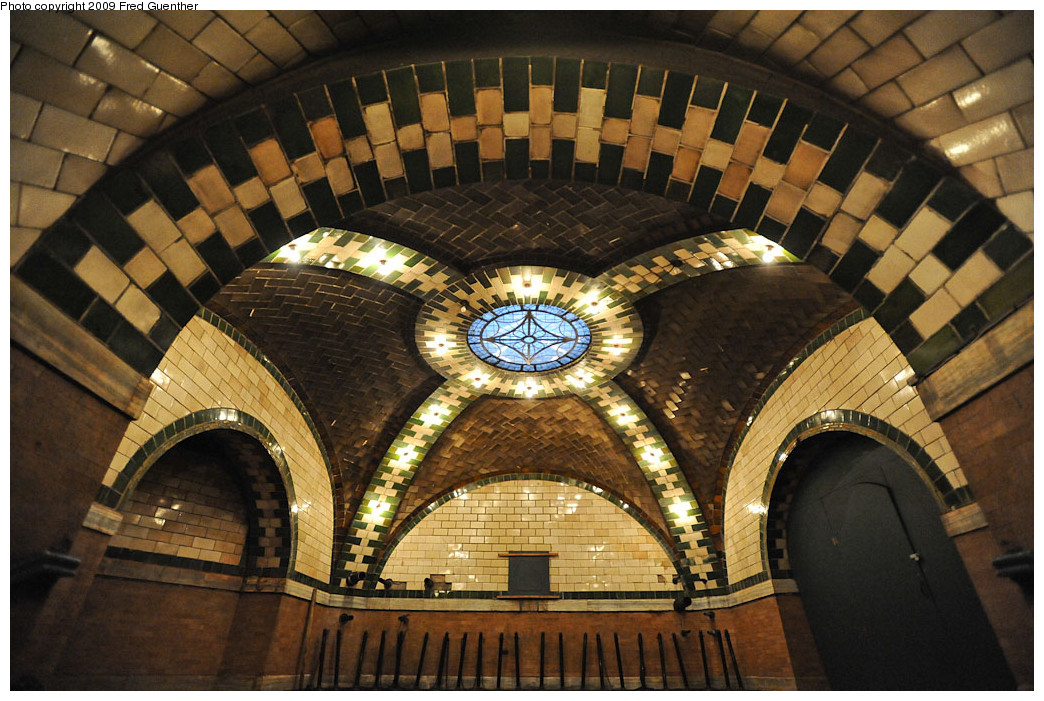
City Hall at night. Source: www.nyc-architecture.com

Jacob Wrey Mould Fountain in City Hall Park. Source: www.wirednewyork.com
I passed by City Hall twice every day in high school: on my walk to school, and on my walk back. City Hall Park, the public space surrounding City Hall, was a nice place to relax and chat with friends on a warm day. Even today, as I get out of the 6 train station at Brooklyn Bridge-City Hall, I can look past the Municipal Building and catch a glimpse of City Hall. Despite my many interactions with this well-known landmark, I’ve never sought out information about this building, which is why I decided to do my “Then and Now” post on it.

Front view of City Hall. Source: www.nycvisitorinfo.com
The City Hall that I passed by every day between Broadway and Park Row is actually not the original “City Hall”. New York’s very first City Hall was built in the 17th century, on Pearl Street, and the second City Hall was built in the 18th century, on Wall Street. The first building was renamed “Federal Hall” after the Revolutionary War ended and passed its role as City Hall onto the building on Wall Street. The government was quickly growing and a newer, bigger City Hall was needed to accommodate this growth. In 1802, the New York City Council chose the site for the new City Hall (its current site, between Broadway and Park Row) and held a contest for the construction of the new building. Joseph Francois Mangin, a Frenchman, and John McComb Jr., a native New Yorker, won with their proposed plan. After going through further tweaks such as changing the building materials to lower construction costs, City Hall was finally finished in 1811 and opened in 1812. City Hall has a stairs leading to a central pavilion flanked by two wings. The exterior was inspired by the French Renaissance and the interior, by the American-Georgian style.

City Hall Subway Station. Souce: www.nycsubway.org
On October 27 1904, the Interborough Rapid Transit Company built a subway station directly under City Hall plaza. This station was designed by Rafael Guastavino and was described as “the most beautiful subway station in the world”. It was meant to show off the debut of the very first subway line and was unlike anything anyone has ever seen. The station featured “Guastavino arches and skylights, colored glass tilework, and brass chandeliers”.
Now, New York’s City Hall stands as the oldest City Hall in the United States. It was meant to be a Criminal Courthouse but It still carries out the same functions as it was built for, which is to house the office of the mayor and the chambers of the NYC Council. More government buildings joined the neighborhood as time passed, such as the Municipal Building, One Police Plaza and The Thurgood Marshall U.S. Courthouse. City Hall holds special events in the Governor’s Room and offer tours inside the building. Fun facts: Most pickets also held on the steps of City Hall and City Hall serves as a backdrop for NY1 news coverages.

The curved platform of the station, preventing re-construction. Source: www.nycsubway.org
In addition, the City Hall train station no longer exists. As ridership increased, many station platforms had to be lengthened to support the amount of people but since the City Hall station is built on a curve, it wasn’t able to be re-constructed. As a result, the station shut down on December 31, 1945. When you reach the last stop of the 6 train, which is Brooklyn Bridge – City Hall, you are asked to get off the train (but you don’t HAVE to). If you stay on the train, you will pass by the shut down City Hall station and catch a glimpse of its beauty. But beware, the ride can be a bit creepy.
Sources
“A Brief History of City Hall.” NYC.gov. 2004. Web. 24 Mar. 2012. <http://www.nyc.gov/html/om/html/cityhall_history.html>.
http://www.nyc-architecture.com/SCC/SCC026.htm”New York Architecture Images- City Hall.” New York Architecture. Web. 24 Mar. 2012. <http://www.nyc-architecture.com/SCC/SCC026.htm>.
“IRT East Side Line: City Hall.” New York City Subway History, Photos & More. Web. 24 Mar. 2012. <http://www.nycsubway.org/perl/stations?5:979>.
“New York City Council – About City Hall.” New York City Council. Web. 25 Mar. 2012. <http://council.nyc.gov/html/about/city-hall.shtml>.


I never really knew much about City Hall then or now. This is interesting! Nice job with the content and layout Anna, the pictures and place itself are beautiful!
I love your organization and layout of the information and images. I have always wondered why people stay on the train at the Brooklyn Bridge stop, even though it’s the last one!
I really enjoyed reading this post–the writing is engaging, as are the images. I think it would be even stronger if you talked a little more about the framework concept (Great Depression-Great Recession)–perhaps in the context of protest.
A few months ago, I translated a book from Chinese to use in my latest research project. The author was a hand laundry owner who lived in NYC in the 1930s and then returned to China in the 1940s. He seems to have been a Marxist, which may have colored his perspective, but this is what he wrote about City Hall in the Depression era:
“Living in Chinatown, you can walk to City Hall in five minutes, and sometimes I would pass the gate of City Hall on the way to work, which then gave me the opportunity to see this ‘shrewish scolding street’ scene. In front of City Hall gate…campaigners’ propagandists lectured in front of the bronze portraits, saying that their candidate was a ‘public servant’ concerned about the common people’s hardships, and therefore if this ‘public servant’ got elected, there would immediately be ‘peace and tranquility under heaven.’ The ‘propagandists’ made the scene lively and exciting, using vulgar methods. First they’d create a situation in which people thought they were an ’employment agency,’ and when unemployed Americans really thought they were an employment agency, one after another they’d go scramble for a job, after which they’d hear that ’employment agent’ speak a lot, saying to everyone that if they cast their vote for Mr. XX, Mr. XX would be elected, and then you won’t have to go through the miserable life of the unemployed but could get a job.”
The translation isn’t lovely (it’s hard to capture the sarcastic tone, but obviously the author didn’t think much of American democracy), but it suggests the kind of political activity and demagoguery that took place at City Hall in the 1930s.
Also, this sentence confused me: “Now, New York’s City Hall stands as the oldest City Hall in the United States. It was meant to be a Criminal Courthouse but It still carries out the same functions as it was built for, which is to house the office of the mayor and the chambers of the NYC Council.” Didn’t designers intend for City Hall to be a municipal government center rather than a courthouse?
One other comment: I’d like to see you do the photos yourself, unless they’re old photos or pictures of interiors that you can’t access.
I think it’s really interesting that you chose a location you pass by so frequently and to see how much you’ve learned from your research about it!
I think your post is very interesting and easy to read. I didn’t feel like I was bombarded with too much information. And I never knew I could stay on the train past the last stop..I will definitely do that one day!